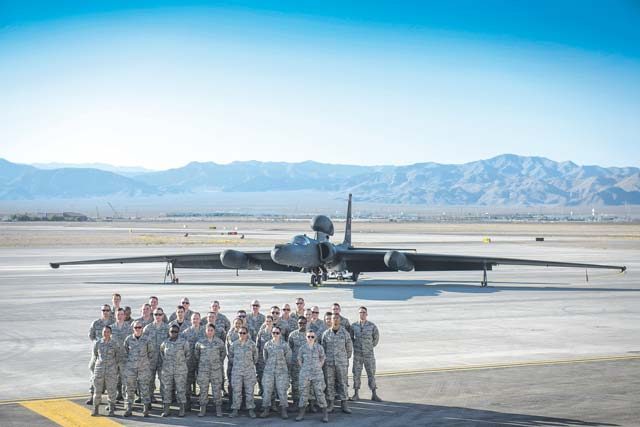
The Distributed Ground Station-4 team takes a team picture in front of the U-2 during the Red Flag 16-3 exercise July 11 to 29 at the Nevada Test and Training Range on Nellis Air Force Base, Navada. The mission of Red Flag is to provide unrivaled air, space and cyber combat power for America by combining available assets to create the most realistic possible air, ground and space threat environment for combat training.
The 693rd Intelligence, Surveillance and Reconnaissance Group, stationed at Ramstein, participated in the Red Flag 16-3 exercise July 11 to 29 at the Nevada Test and Training Range on Nellis Air Force Base, Nevada.
The mission of Red Flag is to provide unrivaled air, space and cyber combat power for America by combining available assets to create a realistic air, ground and space threat environment for combat training. This exercise provides a forum for face-to-face exchange of ideas and lessons learned between joint and combined forces.
The 693rd ISRG Distributed Ground Station-4 trained while supporting various groups during the exercise. The DGS-4 team consisted primarily of Airmen from the 693rd ISRG, representing the 24th Intel Squadron, 450th Intel Squadron, 402nd Intel Squadron and 693rd Intel Support Squadron, but they were also augmented by one airman each from DGS-1, Joint Base Langley-Eustis, Virginia; DGS-2, Beale Air Force Base, California; DGS-5, Joint Base Pearl Harbor-Hickam, Hawaii; DGS-Kansas; and DGS-Massachusetts.
“The DGS-4 team was a critical element in the planning and execution of numerous missions during Red Flag,” said U.S. Air Force Lt. Col. Christopher Workinger, DGS-4 Red Flag Detachment commander. “Ultimately, we brought the combat capability of the U-2, RQ-4, National Technical Means and fusion analysis through the Distributed Common Ground System weapons system to mission commanders, aircrews and cyber and space operators during 12 missions covering defensive counterair, offensive counterair, air interdiction, strategic attack, dynamic targeting, and combat search and rescue.”
Throughout planning and execution, DGS-4 Airmen interacted with every combat capability that was present at Red Flag 16-3 and across every domain the Air Force operates in — air, space and cyberspace.
Many objectives dealt with optimizing ISR operations against specific tactical problems, integrating with other USAF and joint capabilities, maximizing ISR cross-cues, and ultimately exercising and showcasing all of the DCGS’ geospatial intelligence and signal intelligence capabilities.
“We got better each day,” Workinger said. “We learned with each mission and raised the bar every day, and we eventually got to the point where the Red Flag staff and major command observers highlighted the DGS-4 team as the best they’d seen at Red Flag since the DGS crews were introduced to the exercise.”
The DGS-4 team showcased the capabilities and tactics of the DCGS platform and, most importantly, how the exploitation and dissemination process can enhance a mission commander’s plan. By being present for planning and execution, they were able to demonstrate what DGS Airmen bring to the fight in terms of GEOINT and SIGINT, and that is not widely understood by the combat air forces.
“With a few very minor exceptions, we met all of our objectives and had a very, very successful exercise, but being mission complete doesn’t mean we can rest,” Workinger said. “The entire team was energized to get back to Ramstein Air Base, Germany, and integrate what we have learned into our processes here at home station. There is always room for improvement when it comes to combat capability against an ever-changing adversary.”


